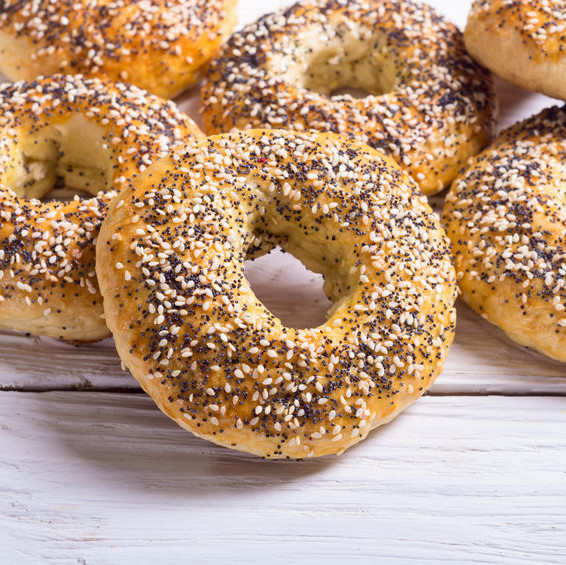
Bagel
What is Bagel?
A bagel is a type of bread roll with a special O-ring shape. It is characterized by a shiny, tough crust and a chewy crumb. These features are the result of the bagel’s composition, its long retarding time and the dough boiling step prior to baking. Traditional style bagels are very chewy while commercial bagels tend to have bread-like texture.
Various styles of bagels are commonly known such as New York, Chicago, Montreal and others. Differences among them are often based on:
- Texture
- Degree of chewiness
- Kilning
- Baking methods
Origin
The origin of bagels has been recorded by many historians. Some claim that the name ‘bagel’ comes from the Austrian-German word ‘bugel’ which means a stirrup. This in reference to the bread rolls made to honor the Polish King, Jan Sobieski, and his horsemen for their decisive victory against the Ottoman Empire In 1683.1 Others claim that the word ‘bagel’ is derived from the Yiddish word ‘beygel,’ Jewish Polish community regulations in 1610 imposed the practice of giving bagels to mothers after childbirth.2
Bagels were originally brought to the U.S. by Polish Jewish immigrants who settled in the North East area. The Polish-American baker, Harry Lender and his sons introduced bagels to Americans in the Midwest and the rest of the country.3
Bagels were made by hand until 1960 when Dan Thompson invented the first bagel-forming machines. In 1962, the Lender company introduced frozen bagels which were made on high speed production lines and sold through supermarkets.3
How is a bagel made?
Following is a typical bagel formula, using a no-time dough system:4,5
| Ingredient | Baker’s % |
| Patent flour (high gluten bread flour)* | 100.0 |
| Water | 45.0–52.0** |
| Fresh yeast (compressed) | 0.5–1.5 |
| Salt | 1.25–2.0 |
| Refined sugar (granulated) | 0.0–3.0*** |
| All purpose shortening / vegetable oil | 0.0–5.0 |
| Mold inhibitor | 0.3–0.5 |
* High gluten flour with 13.5–14.5% protein and 0.50% ash.
** Low flour hydration for restricting pan flow so that the product can hold its shape during forming, proofing and baking.
*** Low level of sugar. Sufficient amount as food for yeast to obtain desired volume during proofing and prevent too dark crust during longer baking times.
Processing
Production of bagels is done using the following steps:
- Ingredient scaling/metering
- Mixing: time and intensity are determined by dough stiffness and desired extensibility. Spiral or horizontal mixers are the most efficient for bagel dough. It is critical to maintain the formed dough at 24–29°C.
- Dividing: small dough buns are cut using piston-type dividers, rotating knives or bun presses.
- Forming: a bagel’s ring structure is formed by using specialized horizontal or vertical formers.
- Proofing: best done at 38–43°C and 65–75% RH for 60 minutes.
- Retarding: the dough should be stored under refrigeration for 24 to 48 hours.
- Boiling / kettling: the formed rings are dipped into a 2.5% water-sugar or malt solution at 100°C for 1 to 2 minutes. The bagel pieces will sink first for about 30 seconds and then float to the top where they are picked off and dried quickly.
- Baking: ideally at 200–232°C for 18–20 minutes or until structure is set and desired crust color is obtained.
- Removal from oven and cooling.
- Packaging or serving.
Commercially, bagels are available in the form of proofed, boiled and frozen or par-baked or fully baked.
Application
Bagel formulations are very similar to those of simple bread and rolls. What differentiates bagels, however, are the high protein flour (13-16%),6 retardation and boiling steps.
High protein flour and the mixing of bagel dough to full development are essential for its unique chewy texture. High protein flours can be prepared by blending standard patent flour with semolina or by fortifying lower quality flours with vital wheat gluten. Addition of oxidizing agents, strengtheners or emulsifiers is also an option for enhancing the flour quality via improving gluten aggregation.
Bagel dough is very stiff and its mixing can be energy-intensive. Spiral mixers are used with small- and medium-size batches while large batches require horizontal mixers. The formed stiff doughs can be processed without flour dusting.
Bagels’ unique flavor and distinct crust are a result of the cold yeast fermentation step, known as retardation. Yeast levels can be adjusted depending on the processing conditions and speed of line. The lower the proofing temperatures, the higher the yeast level needed. Similarly, the longer the proofing time, the lower the yeast level needed.
Boiling or kettling has three main functions:
- Accelerates yeast inactivation
- Provides shiny appearance
- Controls bagels expansion
Maintaining required kettling water temperature (above 100°C) is often done by adjusting the sugar or salt concentrations.
References
- Nobody Really Knows Why Bagels Exist. The Business Insider. https://www.businessinsider.com/history-of-the-bagel-2016-2. Accessed 13 October 2018.
- Weinzwig, A. The secret history of bagels. 2008. https://www.theatlantic.com/health/archive/2009/03/the-secret-history-of-bagels/6928/
- Frost, N. The forgotten history of New York’s bagel famines. 2018. https://www.atlasobscura.com/articles/bagel-union-strikes-new-york-city
- Labensky, S.R., and Martel, Priscilla. “Artisan and Yeast Breads” On Baking: A Textbook of Baking and Pastry Fundamentals, 3rd edition update, Pearson Education, Inc., 2016, pp. 168–505.
- Gisslen, W. “Lean Yeast Doughs: Straight Doughs” Professional Baking, 7th edition, John Wiley & Sons, Inc., Hoboken, New Jersey, 2017, pp. 135–153.
- Bath, D.E. and Hoseney, R.C. A laboratory-scale bagel-making procedure. Cereal Chem. 1994, 71, 5, pp. 403-408.

